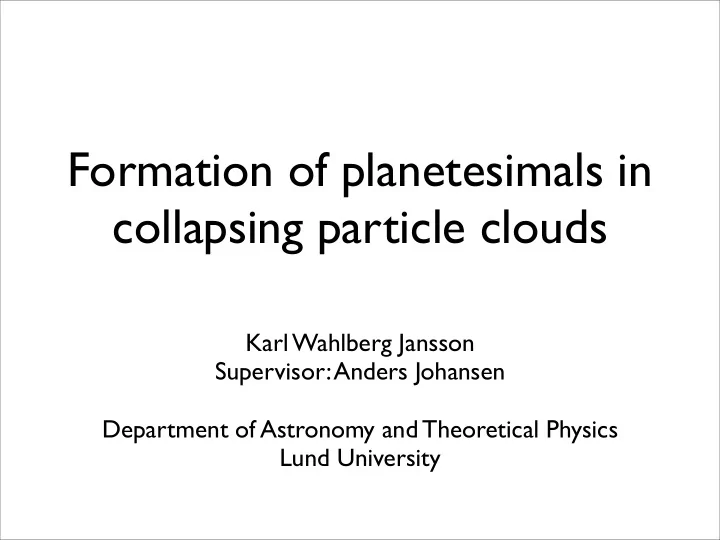

Formation of planetesimals in collapsing particle clouds Karl Wahlberg Jansson Supervisor: Anders Johansen Department of Astronomy and Theoretical Physics Lund University
Stages of planet formation Credit: Daniel Carrera
Stages of planet formation • Formation of planetesimals, the Credit: Daniel Carrera building blocks of planets • E.g. Pluto and Kuiper belt objects
New Horizons: A mission to the outer Solar System • NASA fly-by mission to Pluto • Launched in January 2006 • Arrives in 2015 • Will fly by Pluto, its moons and some other KBOs once and never be seen again
Problems • Larger particles (mm/cm) don’t stick very well • High relative velocity reduce the sticking capacity • Other outcomes: - Bouncing - Fragmentation
Formation of a self-gravitating cloud • Gravitationally bound clouds of pebbles can form through the streaming instability • Unresolved in hydrodynamical simulations
Solution to the problem? • What happens to a self-gravitating cloud of cm- sized pebbles in virial equilibrium? • Inelastic collisions would dissipate away energy • Negative heat capacity ⇒ system ‘heats’ up • Collision rates increases ⇒ runaway collapse
Simple scenario • Bouncing collisions dissipate energy • Analytically solvable with very short collapse time • For Pluto mass cloud at Pluto’s distance from the Sun: t crit ~ 0.73 yrs
More realistic model • One Pluto split into cm-sized pebbles results in ~10 24 pebbles • Use a statistical approach: Monte Carlo scheme of Zsom & Dullemond, 2008, A&A • Look at a smaller number of representative particles/swarms of identical particles
Representative particle approach Collision between swarm i and swarm k (1000 representative particles)
Numerical implementation • Calculate collision rates of particles from number density, size and relative velocity of particles • From total collision rate find time until next collision • Outcome of collision from particle properties: - Coagulation, fragmentation or bouncing - Energy dissipated - New particle properties: size, velocity, etc.
Colisional outcomes Large projectile or similar sized particle: f ≥ 0 . 1 Large projectile or similar sized particle: f ≥ 0 . 1 Large target: f < 0 . 1 Large target: f < 0 . 1 0.1 0.1 0.1 0.1 Projectile radius (m) Projectile radius (m) Projectile radius (m) Projectile radius (m) B B B B 0.001 0.001 0.001 0.001 v stick v stick v stick v stick C C F F C C C C F F 1e-05 1e-05 1e-05 1e-05 1e-06 1e-06 0.0001 0.0001 0.01 0.01 1 1 100 100 1e-06 1e-06 0.0001 0.0001 0.01 0.01 1 1 100 100 Collision speed, ∆ v , (m/s) Collision speed, ∆ v , (m/s) Collision speed, ∆ v , (m/s) Collision speed, ∆ v , (m/s) (Güttler et al. 2010) • Outcome depends on particle size, collision speed and relative size
Collapse of pebble cloud Collapse parameter η as function of time. Simulated η Simulated η eq Free-fall collapse 1 0.8 0.6 η (R/R 0 ) 0.4 0.2 0 0 10 20 30 40 50 Time (yrs)
Collapse time Collapse time as a function of solid radius of the planetesimal. 10000 Simulations Power-law fit 1 Power-law fit 2 Free-fall time of initial particle cloud 1000 Collapse time (yrs) Bouncing Fragmenting 100 only collisions 10 1 0.1 1 10 100 1000 10000 100000 Solid radius (km)
Conclusions • Collapse times are short • Prediction for KBOs: - High mass: Sand spheres - Low mass: Pebble piles
Thank you for your attention!
Recommend
More recommend